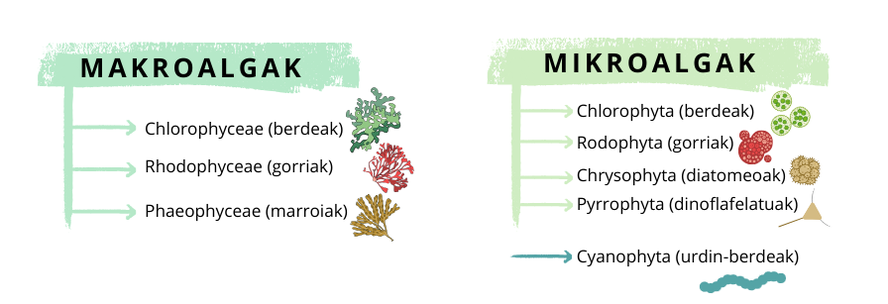Algae and microalgae: a food bet of the future?
Sustainability is fundamental to the conservation and survival of our planet, and through food we can contribute a lot. Among the sustainable foods we can consume in the future are algae and microalgae, which have a low impact on their production, which can be an alternative to animal protein and contain a large number of bioactive compounds beneficial to health.
It is known that the population grows every year and that we are becoming more and more inhabitants in the world (1). Studies suggest that, in a context of waste of food sources, it will not be sustainable to continue with this level of production and consumption (2,3). Sustainability is based on three main points (4, 5). First of all, although nature provides many resources in the conservation of the environment, today we consume more resources than the planet can generate. Furthermore, sustainability takes into account the social development of cultures and communities and ensures coexistence, health and education. Finally, the third key point is to ensure economic growth that does not harm the environment (6).
Although talking about sustainable food is complex, ultimately the key is to reduce the environmental impact of our food pattern. In order to do so, in the process between food production and consumption, we will have to consume those foods with less environmental impact. Reducing the consumption of food of animal origin, especially reducing meat consumption, appears to be one of the most effective changes.
In fact, it is known that basing our food on plant-based foods is more sustainable. That is why our basic foods should be legumes, vegetables, fruit, whole grains and nuts and, to a lesser extent, of animal origin. Seasonal and local food should also be consumed in order to promote sustainability, as the production process spends less resources and reduces transport pollution (7).
In 2019, the “Report of the 50 Foods of the Future” was published, a document that lists the 50 foods that can be consumed in the future in a healthier and more sustainable diet (8). Basically, the criteria used to select the 50 foods and enhance their consumption are: their high nutritional value, their lower impact on the environment than food of animal origin, their accessibility and their good taste. The list of 50 foods that have been selected includes algae.
Algae: characteristics, classification and uses
Algae consumption has been traditional since ancient times in East and Southeast Asia, but, as a result of globalization and export, today they are part of the world's gastronomic. Currently, the most well-known and consumed algae are the algae to whom, kombu or wakame, which are mainly used in sushi, soup, salad or fish dishes. In general, what we call algae are macroalgae; as we will explain below, there are also microalgae.
Macroalgae are large multicellular organisms classified into three subgroups according to colour; Chlorophyceae (green), Rhodophyceae (red) and Phaeophyceae (brown) (9). Microalgae are single-celled eukaryotic organisms of microscopic size, also known as phytoplankton. The classification of microalgae is: Chlorophyta (green), Rhodophyta (red), Chrysophyta (diatomeas) and Pyrrophyta (dinoflagellates) (10, 11). Image). There are also cyanobacteria (Cyanophyta, blue and green prokaryotic cells), which although they have been classified as microalgae, as prokaryotic cells are not classified as microalgae (11). The best known microalgae are spirulina and Chlorella, which, in addition to being used for food production, are also used for the manufacture of food additives and cosmetic products.
Many macroalgae are marketed dried, so it is necessary to hydrate them before consumption to eat raw or cooked. However, microalgae are not used for direct consumption, but are used in addition to food or dishes as a food supplement or as a product made with microalgae, such as bread or cookies. Macroalgae are generally obtained from the seas, while microalgae are produced in bio-photoreactors that allow their controlled growth. In bio-photoreactors, they grow in many small vessels associated in the form of a glazed balloon, with optimal conditions of light, temperature and pH with water and food (Figure 2).
As mentioned above, microalgae are microscopic in size, and what is obtained from production is a biomass in the form of adhesive paste that is not consumed directly. From biomass, a lyophilization of the microalgae can be carried out to obtain the powder or derivatives of all the microalgae that can be added to food or, as already mentioned, for the production of products made with microalgae (Figure 3). On the other hand, microalgae are used for the extraction of bioactive compounds, compounds with benefits for human health, very useful for the food and pharmaceutical industry (14).
Algae: source of bioactive compounds beneficial for health
As mentioned above, macroalgae and microalgae contain bioactive compounds, molecules with benefits in the prevention and treatment of various diseases, as many studies have reported (15, 16). These bioactive compounds include florotanins, fucoidans, alginates, laminarins, carotenoids (fukoxanthine, for example) and sterols (fukosterol), and have been shown to be beneficial in preventing diseases such as 17. For example, florotanins have been shown to have type 2 antidiabetic activity, as they contribute to a decrease in blood glucose levels, by inhibiting the enzyme activity α-amylase and α-glucoylase (18). Furthermore, it has been observed that the intake of bioactive compounds present in algae has benefits in the treatment of obesity, such as delayed gastric emptying, decreased inflammation and reduced spread of fatty tissue (19). On the other hand, carotenoids present in algae have an antioxidant effect, act against oxidative stress and help prevent many chronic degenerative diseases (20, 21). It should be noted that cardiovascular diseases, together with cancer, are the ones that cause the most mortality (22) and that carotenoids can reduce their incidence due to their hypertension, thrombosis, hyperlipidemia and effect on atherosclerosis (23). Finally, in addition to the above effects, bioactive algae compounds have antibacterial activity, have benefits in neurodegenerative diseases, such as Alzheimer's, and have been found to have effects against cancer (17, 20, 24, 25, 26).
Will we consume algae and microalgae in the future?
If we take into account that algae contain bioactive compounds with beneficial health effects and that the nutritional composition is very appropriate – that is, that they may be useful for replacing in future food of animal origin – it seems interesting to include algae in our usual feeding pattern. It must be borne in mind, however, that in our society they are not consumed on a daily basis, as they have a very characteristic taste. In addition, macroalgae taken from the sea should be taken moderately, so as not to exceed safe quantities limits for heavy metals.
Today there are many algae marketed that we can consume directly, added to salads or soups, or as products made with them. As far as microalgae are concerned, although their use is slightly more limited, there are products made with them on the market. And in the coming years, a brutal boom in the microalgae market is expected.
Bibliography:
- https://ourworldindata.org/population-growth
- Herrero M, Wirsenius S, Henderson B, Rigolot C, Thornton P, Havlík P, Boer I and Gerber PJ. 2015. Livestock and the Environment: What have we learned in the past decade? Annual Review of Environment and Resources, 40, 177-202.
- Mottet A, by Haan C, Falcucci A, Tempio G, Opium C and Gerber PJ. 2017. Livestock: on our plated or eating at our table? A new analysis of the feed/food debate. Global Food Security, 14, 1-8.
- https://www.fao.org/nutrition/educacion-nutricional/food-dietary-guidelines/background/sustainable-dietary-guidelines/es/
- Carr-Ugarte H, Jiménez M, Aguirre L, Portillo MP and Eseberri I. 2023. Hori gara bat behar da. Publications Service of the University of the Basque Country, Leioa.
- https://www.un.org/es/impacto-acad%C3%A9mico/sostenibilidad
- https://municipiods.com/productos-kilometro-0/
- Shaver D. Future 50 foods. In: WWF Ka, editor. Dietitian and Global Knorr Sustainability Lead; 2019.
- Montero L, Sánchez-Camargo AP, Ibañez E and Gilbert-López B. 2018. Current Medicinal Chemistry, 25, 4808-4826.
- Ahmed E, Suzuki K and Nishida T. 2023. Micro- and Macro-Algae Combination as a Novel Alternative Ruminant Feed with Methane-Mitigation Potential. Animals 13, 796.
- Dini I. 2023. The potential of algae in the nutricosmetic sector. Molecules. 4032.
- https://www.laopiniondemurcia.es/comunidad/2022/01/09/boom-cultivo-microalgas-region-cubrir-61382658.html
- https://ibizabotanicobiotecnologico.com/ibb/
- Barkia I, Saari N and Manning SR. 2019. Microalgae for high-value products towards human health and nutrition. Marine Drugs, 17, 304.
- Gómez-Zorita S, Trepiana J, Gozález-Arceo M, Aguirre L, Milton-Laskibar I, González M, Eseberri I, Fernández-Quintela A and Portillo MP. Anti-obesity effects of microalgae. 2020. International Journal of Molecular Sciences, 21-41.
- Biris-Dorhoi E-S, Michiu D, Pop CR, Rotar AM, Tofana M, Pop OL, Socaci SA and Farcas CA. 2020. Macroalgae – A sustainable source of chemical compounds with biological activities. Nutrients 12, 3085.
- Kumari A, Garima and Bharadvaja N 2023. A comprehensive review on algal nutraceuticals as prospective therapeutic agent for different diseases. 3 Biotech, 12, 44.
- Lee S-H and Jeon Y-J 2013. Anti-Diabetes effects of brown algae derived phlorotannins, marine polyphenols through diverse mechanisms. Phytotherapy, 86, 129-136.
- Wan-Loy C and Siew-Moi P. 2016. Marine algae as a potential source for anti-obsity agents. Marine Drugs, 14, 222.
- Equipment: Silva J, Alves C, Freitas R, Martins A, Pinteus S, Ribeiro J, Gaspar H, Alfonso A and Pedrosa R. 2019. Antioxidant and Neuroprotective Potential of the Brown Seaweed Bifurcaria bifurcata in an in vitro Parkinson’s disease model. Marine Drugs, 17, 85.
- Chen P, Shang X, Huang X, Zhang M and Guo J. 2024. Recent advance of physicochemical, structural properties, potential health benefits and application of bioactive macromolecules from Porphyra haitanensis: Revision a. Internationes Journal of Biological Macromolecules, 279, 135497.
- Audicana Uriarte C. 2022. Mortality in the Autonomous Community of the Basque Country. Directorate of Health Planning, Management and Evaluation, Department of Health. Basque Country.
- De Jesus Rapose MF and Miranda Bernardo de Morais AM. 2015. Microalgae for the prevention of cardiovascular disease and stroke. Life Sciences, 125, 32-41.
- Arvinda Swamy m.l. 2011. Chapter 6 - Marine algal sources for treating bacterial diseases. Advances in Food and Nutrition Research, 64, 71-84.
- Sami N, Ahmad R and Fatma T. 2021. Exploring algae and cyanobacteria as a promising natural source of antiviral drug against SARS-CoV-2. Biomedical Journal, 44, 54-62.
- Khotimchenko M, Tiasto V, Kalitnik A, Begun M, R de Khotimch, Leonteva E, Bryukhovetskiy I and Khotimchenko Y. 2020. Potemtoal antitumor of carrageenan from marine algae. Carbohydrate Polymers, 246, 116568.








